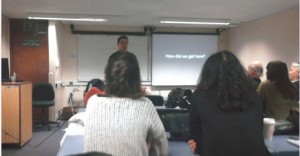On Friday afternoon, February 8th, I attended a guest lecture hosted by the University of Kent . The guest speaker was Professor Niigaanwewidam James Sinclair. Such an interesting name drew my attention to the event, and I discovered that Professor Sinclair is an indigenous Canadian, who lectures at the University of Manitoba in Canada, and is also an activist and author.
Professor Sinclair’s lecture was about the ‘Idle No More’ movement. As someone who has lived in Canada for much of my life, I have a general idea of the difficulties faced by indigenous Canadians, and was curious to learn more. Idle No More is a mass movement that uses peaceful demonstrations to protest the policies and laws that have colonized the indigenous peoples of Canada and led to their loss of territory and a deterioration in their quality of life. This so-called land grab is largely because of the oil and diamonds offered by the land on which the indigenous populations live.
As a student of International Law with a focus on Human Rights, there were two aspects of Professor Sinclair’s speech that stood out for me: (i) amendments by Bill c-45 which touch on voting rights and the right to land and (ii) the Ringdance which relates to the right to peaceful protest.
The creation of Bill c-45 amendments to 24 legal instruments is the impetus for the formation of Idle No More. Previously, under the Navigable Waters Protection Act 1882, certain lakes and other bodies of water were protected from pipelines, construction, mining and other forms of interference. The amendments remove these protections from bodies of water not mentioned in the Bill.
Bill c-45 also amends voting procedures under the Indian Act 1985. Whereas before, determining whether land could be privatized was determined by a majority vote by the indigenous community, this has been severely curtailed. In light of the government deeming this procedure “costly and time-consuming”, the new voting procedure only requires a majority vote by those present, and a vote can be called with very short notice. Therefore if three persons attend the vote out a community of thousands, two of those persons can determine the fate of the entire community. The result has been the involuntary relocation of indigenous populations.
The second aspect of the lecture that I reflected on was the Ringdance. Professor Sinclair described a Ringdance that was held at a mall in Winnipeg, Manitoba in 2012 ( a video of the event is hyperlinked to the word ‘Ringdance’). The Ringdance involves forming a closed circle (a ring), and dancing, or stepping to keep the circle moving. There is also drumming and singing. What is significant about the Ringdance, as described by Professor Sinclair, is that there is initially a bit of chaos as people are slightly flustered and uncoordinated. However eventually, those in the ring begin to move together, understanding and anticipating the movements of the people on either side of them. Observers passing by decide to join the ring, or unintentionally are swept up in the movement. The ring becomes like a heartbeat with people of all ages and different races moving in time to the rhythm. One can imagine the impact of that when the ring contains upwards of 400 people. This symbolizes the vision of Idle No More, in that the teachings and the goal of the movement will spread and continue to spread until their goal is achieved: recognition of the national sovereignty of indigenous persons across Canada.
For those who are interested in getting involved, the movement has a significant online presence. Professor Sinclair has created the hash tag #IdleNoMoreKent, and encourages everyone to become leaders in continuing the discourse about the rights of indigenous peoples.

